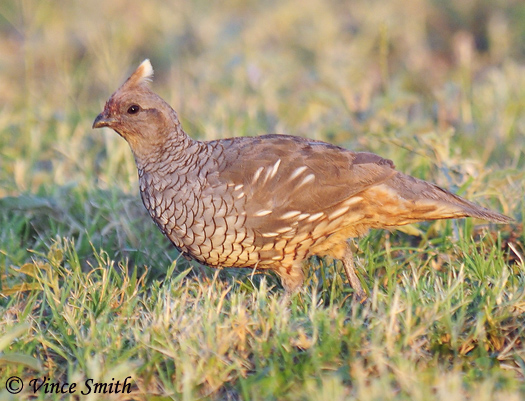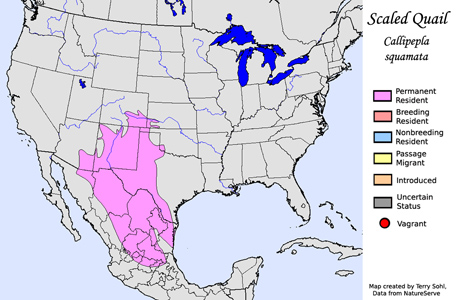| Length: 10 inches | Wingspan: 14 inches | Seasonality: Non-resident in South Dakota |
| ID Keys: Obvious scaly pattern on underparts and neck, white tuft on head, grayish-tan overall, generally plain face | ||
 Scaled
Quail are a fairly common bird of dry grasslands in teh southern Great Plains
and southwestern U.S. They are closely related to a pair of other western
quail species, the Gambel's Quail and
California Quail, but while those two
species are very similar in appearance, the scaled quail is distinct in
appearance, with an obvious, large scaly pattern to the plumage on the
underparts and neck. They have a tuft of feathers on the head that is
white along the upper edges, leading to an informal name of "cotton-top quail"
in many locations. Like other quail species, they often remain hidden and
inconspicuous, but in the spring, males can often be seen on fence posts or
other higher perches as they call.
Scaled
Quail are a fairly common bird of dry grasslands in teh southern Great Plains
and southwestern U.S. They are closely related to a pair of other western
quail species, the Gambel's Quail and
California Quail, but while those two
species are very similar in appearance, the scaled quail is distinct in
appearance, with an obvious, large scaly pattern to the plumage on the
underparts and neck. They have a tuft of feathers on the head that is
white along the upper edges, leading to an informal name of "cotton-top quail"
in many locations. Like other quail species, they often remain hidden and
inconspicuous, but in the spring, males can often be seen on fence posts or
other higher perches as they call.
Habitat: Scaled Quail are most often found in areas of grasslands with scattered weeds and shrubs They are more often found in open grassland areas with few shrubs than the other closely related Callipepla quail (Gambel's Quail, California Quail).
Diet: Feeds heavily on seeds, especially the seeds of annual and perennial weeds. They also eat many insects, especially during the spring and summer months. Other food items include berries, leaves, buds, and flowers.
Behavior: Gregarious, foraging and moving in small coveys of birds in most seasons. Early in the breeding season, they will forage more as breeding pairs or small family units. .
Nesting: Nests are constructed on the ground in a shallow depression. It is usually placed at the base of a shrub or other plant that provides cover, and made of grasses and leaves. Females do the majority of the incubation of eggs, but both parents will tend to the young.
Song: Males have a high shrieking call, as well as a
slow two-syllable clucking.Migration: Considered a permanent resident throughout
their range.
Interactive eBird map:
Click here to access an interactive eBird map of Scaled Quail sightings
Feeders: Scaled Quail will visit ground feeders for seed, or scattered seeds.
Similar Species:
While similar in size and structure to other quail species, they are generally
unique in appearance and readily recognizable with a decent view.
Conservation Status: The IUCN ranks Scaled Quail as a
species of "Least Concern". The species is still widespread and common, although
there are indications of sharp declines in the last several decades. They
are most vulnerable to overgrazing, and may reproduce very poorly in areas of
intensive livestock management.
Further Information: 1)
Cornell's All About Birds - Scaled Quail
2)
USGS Bird
InfoCenter - Scaled Quail
3)
Texas Parks and Wildlife - Scaled Quail in Texas
Photo Information: June 12th, 2011 - Laredo, Texas -
Photo taken by Vince
Smith - Licensed under
Creative
Commons Attribution-NonCommercial-ShareAlike 2.0 Generic license.
Additional Photos: Click on the image chips or
text links below for additional, higher-resolution Scaled Quail photos.
Further Information: 1)
Cornell's All About Birds - Scaled Quail
2)
USGS Bird
InfoCenter - Scaled Quail
3)
Texas Parks and Wildlife - Scaled Quail in Texas
Photo Information: June 12th, 2011 - Laredo, Texas -
Photo taken by Vince
Smith - Licensed under
Creative
Commons Attribution-NonCommercial-ShareAlike 2.0 Generic license.
Additional Photos: Click on the image chips or
text links below for additional, higher-resolution Scaled Quail photos.
| Click on the map below for a higher resolution view |
 |
| South Dakota Status: Non-resident in South Dakota |
Additional Scaled Quail Photos (Coming Soon!!!)
